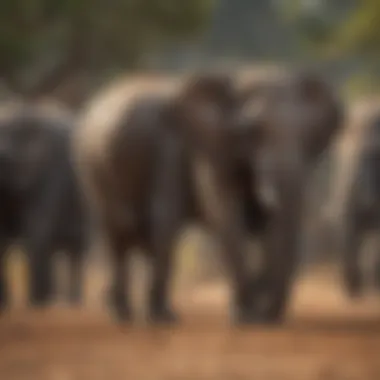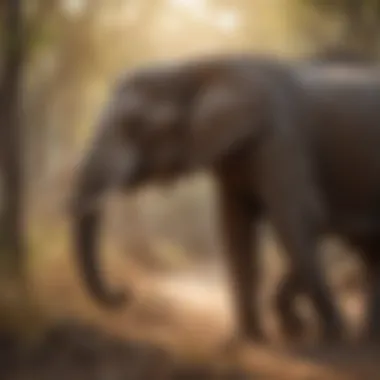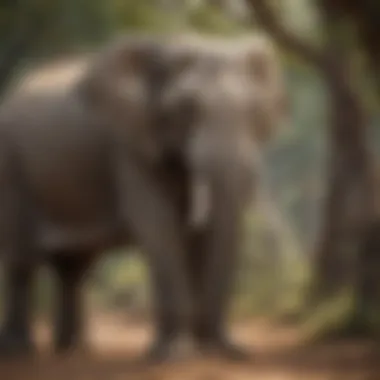Exploring Effective Strategies for Elephant Conservation


Nature Topic Overview
When we delve into the realm of elephant conservation, we are embarking on a crucial journey to safeguard these magnificent creatures. Our exploration will encompass a range of strategies and actions aimed at ensuring the well-being and survival of elephants. From combating the looming threat of poaching to advocating for the preservation of elephant habitats, each facet will be meticulously examined to underscore the pressing need for securing the future of these gentle giants.
Wildlife Wonders
The world of elephants is vast and diverse, with different species exhibiting unique adaptations and behaviors. Understanding the complexities of these majestic beings involves delving into the intricacies of their social structures, migration patterns, and communication techniques. By shedding light on the distinct characteristics of various elephant species, we unveil the mesmerizing tapestry of wildlife that contributes to the rich tapestry of our natural world.
Conservation Chronicles
Elephant conservation is intricately linked to broader environmental awareness and sustainability efforts. Recognizing the pivotal role that elephants play in ecosystem dynamics, we emphasize the importance of fostering conservation and sustainability practices. By highlighting the ripple effects of elephant populations on their habitats and the interconnected web of life, we underscore the urgent need for collective action to protect these iconic animals.
Engaging Excursions
As we embark on this journey to save the elephants, it's essential to equip the younger generation with the knowledge and tools needed to make a difference. Through interactive features like quizzes, puzzles, and hands-on activities, we aim to inspire children to become stewards of nature. By immersing them in the world of elephant conservation through engaging excursions and DIY nature projects, we empower them to take tangible steps towards ensuring a harmonious coexistence with these gentle giants.
Understanding the Importance of Elephant Conservation
Elephants play a pivotal role in ecosystems globally, embodying the essence of keystone species. Their significance transcends boundaries, fostering biodiversity and maintaining the delicate balance of nature. Understanding the Importance of Elephant Conservation is paramount, considering the profound impact these majestic creatures have on their habitats. By delving into the intricate web of ecological interdependencies, we unravel a world where elephants serve as guardians of harmony and vitality.
Significance of Elephants in Ecosystems
Key Role as Keystone Species
Elephants, with their immense size and foraging habits, shape landscapes and habitats by engineering vegetation and controlling plant communities. This key role as Keystone Species highlights their exceptional ability to influence the ecosystem's structure and function. Despite facing various challenges, elephants remain resilient in their capacity to sustain ecological processes essential for biodiversity conservation.
Impact on Biodiversity
The presence of elephants in ecosystems creates a ripple effect, fostering biodiversity by promoting the coexistence of various plant and animal species. Their foraging patterns and movement dynamics contribute significantly to the dispersion of seeds, shaping plant communities and enhancing genetic diversity. Understanding the Impact on Biodiversity underscores the intricate connections between elephants and the intricate tapestry of life they support.


Threats Faced by Elephants
Poaching for Ivory
One of the gravest threats to elephant populations is poaching for ivory, driven by illegal markets and demand. This ruthless practice not only decimates elephant numbers but also disrupts social structures within herds, leading to imbalances in ecosystems that rely on these gentle giants for their vitality.
Habitat Loss and Fragmentation
As human populations expand and development encroaches on natural habitats, elephants face increasing pressure due to habitat loss and fragmentation. The destruction of their living spaces disrupts migration routes, isolates populations, and reduces access to essential resources, posing a severe threat to their survival.
Human-Elephant Conflict
The growing conflicts between humans and elephants, often stemming from competition for resources and space, exacerbate conservation challenges. Mitigating Human-Elephant Conflict requires innovative strategies that promote coexistence and address underlying issues, ensuring the well-being of both species and the sustainability of ecosystems in the long run.
Conservation Initiatives for Elephants
Conservation Initiatives for Elephants play a pivotal role in ensuring the survival of these majestic creatures. By implementing strategic measures to safeguard elephant populations, we can contribute to the overall preservation of biodiversity. The significance of Conservation Initiatives lies in their ability to address pressing issues such as habitat loss, poaching, and human-elephant conflicts. Through proactive conservation efforts, we aim to secure a sustainable future for elephants and promote coexistence with human communities.
Anti-Poaching Efforts
Deploying Ranger Teams
Deploying Ranger Teams is a critical component of anti-poaching strategies. These teams are trained to patrol key elephant habitats, intercept poachers, and prevent illegal activities. The key characteristic of Deploying Ranger Teams is their proactive approach to wildlife protection, ensuring rapid response to potential threats. By patrolling vast territories, Ranger Teams can deter poaching activities effectively, safeguarding elephant populations from harm. Despite challenges like limited resources and rugged terrain, Ranger Teams remain a valuable asset in the fight against poaching.
Utilizing Technology like Drones
Utilizing Technology like Drones revolutionizes anti-poaching efforts by enhancing surveillance and monitoring capabilities. Drones provide aerial coverage of vast landscapes, enabling real-time tracking of elephant herds and identification of potential risks. The key characteristic of using drones is their ability to gather evidence and intelligence without disturbing wildlife. This advanced technology offers a non-invasive method of detecting poaching activities, empowering conservationists to respond swiftly. While drones increase efficiency in patrolling remote areas, their dependence on weather conditions and technical issues pose challenges that require continuous adaptation.
Habitat Protection and Restoration


Creating Wildlife Corridors
Creating Wildlife Corridors involves establishing safe passage routes for elephants between fragmented habitats. These corridors connect isolated areas, allowing for gene flow and promoting genetic diversity within elephant populations. The key characteristic of Wildlife Corridors is their role in mitigating human-induced habitat fragmentation, enhancing wildlife mobility, and reducing human-elephant conflicts. By creating interconnected pathways, conservationists support the natural movement patterns of elephants, ensuring their survival in dynamic landscapes. Despite the benefits, challenges such as land-use conflicts and maintenance costs require proactive management to sustain wildlife corridors effectively.
Promoting Sustainable Land Use
Promoting Sustainable Land Use entails advocating for practices that harmonize human activities with elephant conservation. By encouraging wildlife-friendly agricultural practices and land-use planning, we can minimize conflicts between elephants and local communities. The key characteristic of Sustainable Land Use is its emphasis on long-term sustainability and ecosystem resilience. This approach fosters coexistence between humans and elephants, promoting mutual benefits and preserving natural habitats. While promoting sustainable land use offers multifaceted advantages, balancing economic interests and conservation goals remains a complex challenge that necessitates inclusive decision-making processes.
Community Engagement
Educational Programs
Educational Programs are instrumental in fostering awareness and understanding of elephant conservation among local communities. These programs empower individuals with knowledge about elephants' importance in ecosystems and the threats they face. The key characteristic of Educational Programs is their capacity to inspire positive behavioral changes and cultivate a culture of coexistence. By engaging with schools, households, and outreach activities, educational programs drive collective action towards elephant protection. While educational initiatives yield tangible benefits in raising conservation awareness, sustaining long-term engagement and measuring behavioral impact require continuous evaluation and adaptation.
Alternative Livelihoods
Alternative Livelihoods initiatives offer community members sustainable economic options that reduce reliance on activities harmful to elephants. By creating income-generating opportunities through ecotourism, artisanal crafts, or sustainable agriculture, communities can alleviate pressure on elephant habitats. The key characteristic of Alternative Livelihoods is their potential to foster economic development while promoting conservation values. Through diversification of livelihoods, communities can improve their well-being and contribute to elephant conservation efforts. Despite the advantages, initiating and sustaining alternative livelihoods projects necessitate stakeholder collaboration, market access, and capacity-building to ensure long-term viability and impact.
Global Impact of Elephant Conservation Efforts
Elephant conservation efforts have a profound impact not only on the preservation of a single species but on the entire ecosystem. By safeguarding elephants, we contribute significantly to maintaining biodiversity and ecosystem balance. These majestic creatures play a vital role as keystone species, influencing the diversity and abundance of other species in their habitat. The resilience of ecosystems relies on the presence of elephants, making them a linchpin in the intricate web of life. Without their stewardship, the domino effect on biodiversity would be substantial, leading to cascading repercussions across various species. Additionally, elephants promote seed dispersal and vegetation control, shaping the landscape and fostering ecological richness. The unique characteristics of elephants underscore their irreplaceable position in the ecosystem, emphasizing the critical need to conserve them for the health and stability of our environment.
Link to Biodiversity Conservation
Preservation of Ecosystem Balance
Preservation of ecosystem balance through elephant conservation is pivotal for maintaining the equilibrium of nature. Elephants act as ecological engineers, shaping their surroundings through foraging and movement patterns. By creating clearings in forests and spreading seeds, they influence vegetation dynamics and maintain a diverse array of plant species. This process aids in preventing habitat degradation and monocultures, ensuring the resilience of ecosystems. The delicate balance orchestrated by elephants instills resilience in the face of environmental challenges, safeguarding biodiversity and promoting ecological sustainability. Despite facing threats, the preservation of ecosystem balance remains a crucial aspect of elephant conservation efforts, underscoring the intricate interplay between elephants and ecosystem health within the broader context of biodiversity conservation.
Enhancement of Ecotourism


The enhancement of ecotourism through elephant conservation offers a sustainable approach to wildlife viewing and economic development. By promoting responsible tourism practices centered around elephants, we not only generate income for local communities but also raise awareness about conservation issues. Ecotourism provides opportunities for engagement with nature, fostering appreciation for wildlife and natural wonders. Additionally, it supports conservation initiatives financially, channeling resources towards habitat protection and anti-poaching efforts. Despite its merits, the integration of ecotourism in elephant conservation efforts requires careful management to mitigate potential negative impacts on wildlife and ecosystems. Balancing the benefits of ecotourism with conservation priorities is crucial for ensuring the long-term viability of both economic and environmental sustainability.
Contribution to Sustainable Development Goals
Promoting Environmental Sustainability
The promotion of environmental sustainability through elephant conservation aligns with global efforts to combat climate change and biodiversity loss. By safeguarding elephants and their habitats, we contribute to the preservation of vital ecosystems and the mitigation of environmental degradation. Elephants play a fundamental role in shaping landscapes, promoting plant diversity, and regulating ecosystems through their unique behaviors. Protecting these gentle giants not only ensures the continuity of their species but also supports broader environmental conservation objectives. Environmental sustainability underscores the essence of elephant conservation, emphasizing the intricate connections between wildlife preservation and global sustainability.
Supporting Local Communities
Supporting local communities through elephant conservation initiatives fosters social cohesion and economic empowerment. By involving residents in conservation activities, we create a sense of ownership and responsibility towards wildlife protection. Empowering local communities through education, skill development, and sustainable livelihood opportunities ensures their active involvement in conservation efforts. Furthermore, promoting community engagement enhances the effectiveness of conservation programs, leveraging local knowledge and resources for holistic impact. However, it is essential to address potential challenges such as human-wildlife conflicts and resource competition to ensure the sustainable coexistence of communities and elephants. Supporting local communities through elephant conservation initiatives offers a collaborative approach to achieving conservation goals while prioritizing the well-being of both people and wildlife.
Call to Action for Elephant Conservation
In this pivotal section on Call to Action for Elephant Conservation, we delve into the imperative steps required to safeguard the future of not only elephants but also the delicate ecosystems they inhabit. Understanding the importance of immediate and concerted efforts is paramount in mitigating the threats faced by these magnificent creatures. By advocating for their protection, we are essentially ensuring the preservation of biodiversity and the balance of crucial ecosystems that elephants are pivotal in. This segment serves as a guiding light towards creating a sustainable future where elephants can thrive harmoniously alongside humans.
Individual Responsibilities
Raising Awareness
In the intricate web of Raising Awareness lies a key aspect of driving significant change in the realm of elephant conservation. By shedding light on the perilous plight of elephants, individuals can cultivate a sense of empathy and urgency within communities. This heightened awareness prompts people to take proactive measures in combatting poaching, habitat destruction, and human-elephant conflicts. Emphasizing the importance of disseminating accurate information and fostering a culture of reverence towards these gentle giants can catalyze a wave of positive impact on their preservation.
Supporting Ethical Tourism
Within the realm of Supporting Ethical Tourism, lies a profound avenue of sustainable support for elephant conservation. By encouraging ethical interactions with elephants in their natural habitats, individuals can actively contribute to their well-being while promoting responsible tourism practices. This not only ensures the welfare of the animals but also aids local communities economically. However, it is imperative to navigate the nuances of ethical tourism carefully, keeping in mind the delicate balance between conservation efforts and commercial interests.
Policy Advocacy
Promoting Wildlife Protection Laws
The cornerstone of Promoting Wildlife Protection Laws is indispensable in fortifying the legal frameworks aimed at safeguarding elephants. By advocating for stringent laws to combat poaching, trafficking, and habitat degradation, policymakers lay the groundwork for long-term conservation strategies. These laws act as a deterrent to illegal activities while affording enhanced protection to elephant populations. However, enforcing these laws effectively and consistently is as paramount as their promulgation to ensure their efficacy in combating threats to elephant survival.
Enforcing Anti-Trafficking Measures
At the forefront of Enforcing Anti-Trafficking Measures lies a proactive approach to combating one of the gravest threats to elephant populations - illegal trafficking. By amping up surveillance, imposing strict penalties, and dismantling illicit networks, authorities can stem the flow of trafficked ivory and elephant products. This bolsters conservation efforts by curbing the demand for such items and disrupting the illegal trade networks that fuel the poaching crisis. Nevertheless, the efficacy of these measures hinges on international collaboration, technological advancements, and robust enforcement mechanisms.







